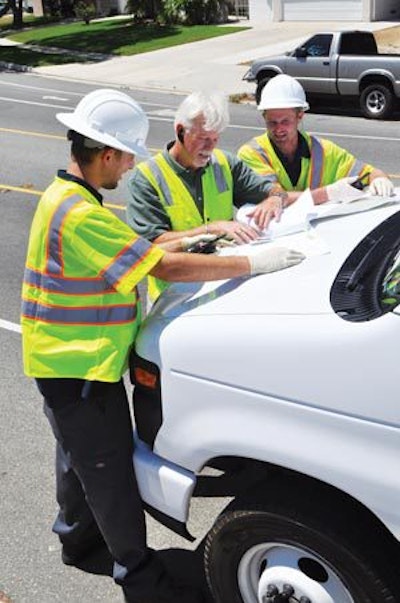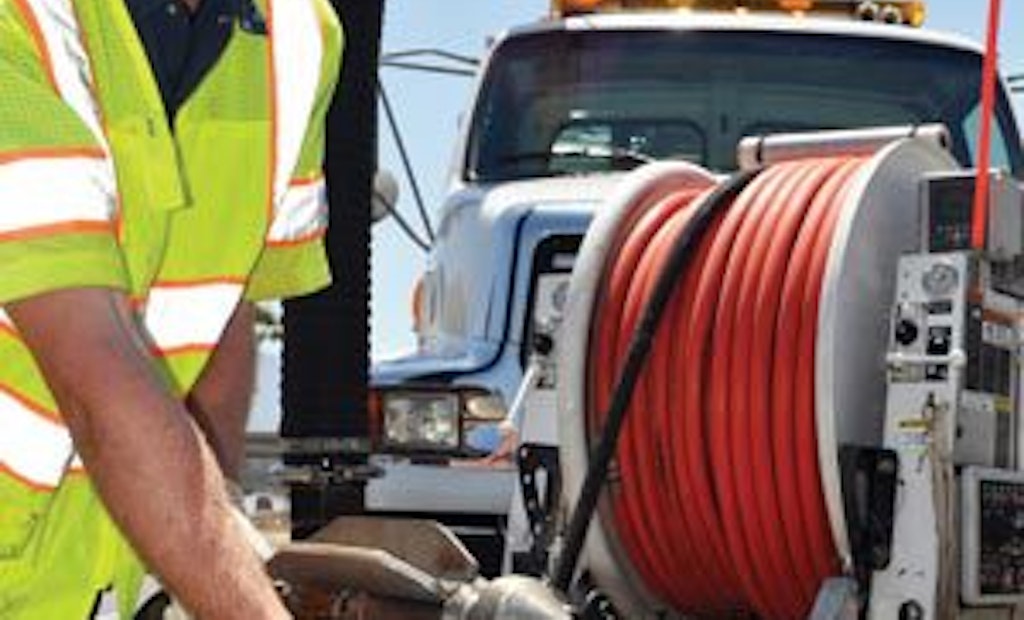As cities and agencies implement sanitary sewer assessment programs, they must decide on their approach to CCTV inspections.
Essentially, there are two schools of thought when it comes to inspecting sewers. The first is to inspect the pipeline without prior cleaning, on the belief that information about the maintenance status of the line is an important part of the assessment. If the pipe is cleaned before the inspection, then information on grease, roots and sediment buildup is lost.
The other approach is to clean the sewer before the inspection, based on the idea that obstructions are then removed that would otherwise block the view of defects. With grease and spider webs out of the way, technicians can make a better assessment on the structural integrity of the pipeline.
There is no right or wrong – either approach can yield a highly satisfactory outcome. However, the “clean first, then inspect” approach poses a few key challenges that need to be overcome: Coordination between the cleaning and inspection crews is critical.
Matter of timing
During clean-and-video programs, contracts often specify a maximum time that can elapse between cleaning and inspection. Since system owners want to see as much of the pipe wall as possible and are concerned that obstructions to the view may return quickly, it is common to see a specification that the pipe must be inspected within 24 hours of cleaning.
This, of course, requires significant coordination between the cleaning and CCTV crews. It takes precise planning to ensure proper execution. In most situations, combination units can clean at a faster rate than a CCTV crew can inspect. This creates a challenge because a combination unit is then restricted on the footage it can clean in a day.
Without proper planning, the cleaning crew will sit idly and unproductive for long periods while waiting for the inspection crew to catch up. One possible solution is to have two CCTV inspection units working alongside one combination unit. This keeps the combination unit working at full capacity.
Proper timing between cleaning and inspection requires close coordination. Crews must meet each day to plan their approaches in detail. Maps should be laid out, and the cleaning crew must clearly specify areas already cleaned. If there is more than one inspection crew, the reaches to be inspected must be clearly defined. There can be no room for error. Missing a reach or inspecting it twice is not an option.
Each crew must have its own set of maps with the areas where they will be working clearly marked. Each day, colored-in portions should be updated so that each map is exactly the same. Any questions, ideas or problems should be discussed during the daily meetings.
Planning should extend out to include the second day and beyond. Each crew member must have a good understanding of where the project is headed. Discussions should include the challenges that can be expected down the road.
Communication throughout the day is vital: It ensures that everyone operates according to the plan, and it provides a means for assistance when crews encounter problems. For example, if inspections reveal that certain sections of pipe need additional cleaning, the cleaning crew can be summoned to do the work immediately. Since the CCTV crew is already set up at the upstream manhole, the combination unit can clean from the downstream manhole and receive immediate feedback on its cleaning effectiveness.
At work simultaneously
Sometimes, crews encounter lines that are difficult to clean, even with multiple passes. In these cases, it may be beneficial to have a camera follow the cleaning nozzle to ensure that it is cleaning effectively. The inspection operator can then direct the cleaning crew on the proper speed, the exact areas where the nozzle should linger, and the areas that need repeated passes.
When mechanical devices such as chain flails and cutters are used, it is imperative for a camera to be there, as well. The damage these tools can inflict on a pipeline can be significant, and it’s important to have an eye in the line to ensure that they are operating as planned.
Sanitary sewer rehabilitation with CIPP lining also requires that nozzles and cameras work together. This is because precise cleaning is required to clear pipelines of any protrusions or debris. A camera must follow the cleaning nozzle to ensure that cleaning takes place to very strict tolerances.
Cameras and nozzles may also be in a line at the same time for educational purposes: Exposing cleaning operators to a visual scene of a functioning nozzle can increase their knowledge and effectiveness.
When cameras and cleaning nozzles operate simultaneously in a line, communication becomes critical, as a cleaning nozzle can inflict costly damage on a camera. In my former career as an operator, I saw this point forcefully demonstrated during the cleaning of a challenging section of pipe.
At that time, the primary form of communication was via Nextel radios. As the inspection operator, it was my job to advise the cleaning operator on the direction of the nozzle. As it approached the camera, I was to tell him by radio when to reverse direction. On one occasion, the radios went silent.
The cleaning operator thought the silence meant he should continue to thrust forward. I watched in horror as the nozzle blasted at full speed into my camera lens. Assuming that he had encountered an obstruction, the cleaning operator continued to pull back and thrust forward, repeatedly striking the head of the camera. After the second collision, the video signal was lost. Arms waving frantically, I got the cleaning operator’s attention, but not before significant damaged was done to my camera.
The moral of the story is that radios and cellular phones have deficiencies: It is common to be working in canyons or in mountains where signal coverage is spotty or nonexistent. Walkie-talkies provide the most dependable communication at close range, and they are also inexpensive.
Setting the protocol
Whenever a camera must be in a pipeline during cleaning, it is a good idea to review the communication protocol beforehand. The cleaning and CCTV crews must understand the meaning of the statements they will use. It is also a good idea to have a contingency plan in case the electronic communication system fails.
That issue aside, the camera and cleaning operators need to coordinate and choreograph their activities. When lines are cleaned and inspected simultaneously, the inspection van typically sets up at the upstream manhole while the combination unit sets up at the downstream manhole. The camera waits for the nozzle to reach the upstream manhole, then follows the nozzle as it is pulled back on its cleaning pass.
The camera should stay at least 10 feet from the nozzle at all times. This gives the CCTV operator enough time to react to any unexpected movements of the nozzle. It also prevents water from splashing on the lens and obstructing the camera’s vision.
The cleaning operator must maintain a steady rate of speed so that the camera can move relative to the speed of the nozzle. Before making any changes in direction, the cleaning operator must notify and receive acknowledgement from the CCTV operator. The same applies to any changes in pressure.
The CCTV operator should never lose sight of the monitor while the nozzle is working. Things can change quickly, and by the time the operator has time to react, a serious situation could develop.
A CCTV operator must always plan for the unforeseen. For example, if it looks like the camera will be hit by the nozzle, the operator should try to articulate the camera head away from the impact. If the nozzle reaches the manhole where the CCTV van is set up, the operator should be prepared to back up into the upstream line. The watchword is: Always be ready for the unpredictable.
Once the nozzle and camera have been removed from the line, operators should meet face to face to discuss any issues that could help them in the future.
Combination units and CCTV inspection cameras can be highly effective when working side by side. With a little planning and coordination, difficult sections of pipe can be cleaned and inspected efficiently, and the accurate data collected can help support sound decisions on repair and rehabilitation.
Jim Aanderud is owner of Innerline Engineering, a video pipeline inspection company based in Corona, Calif.







